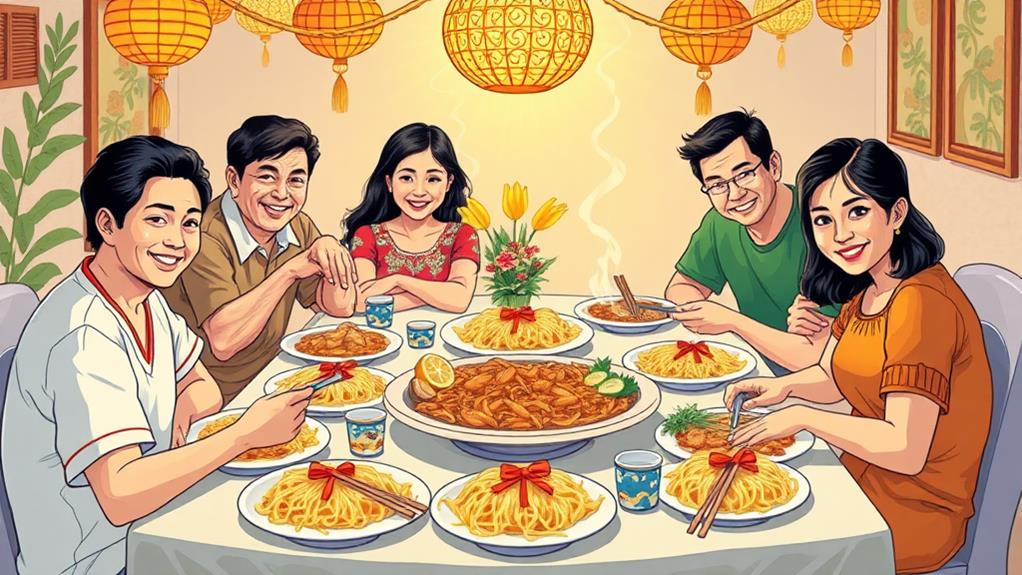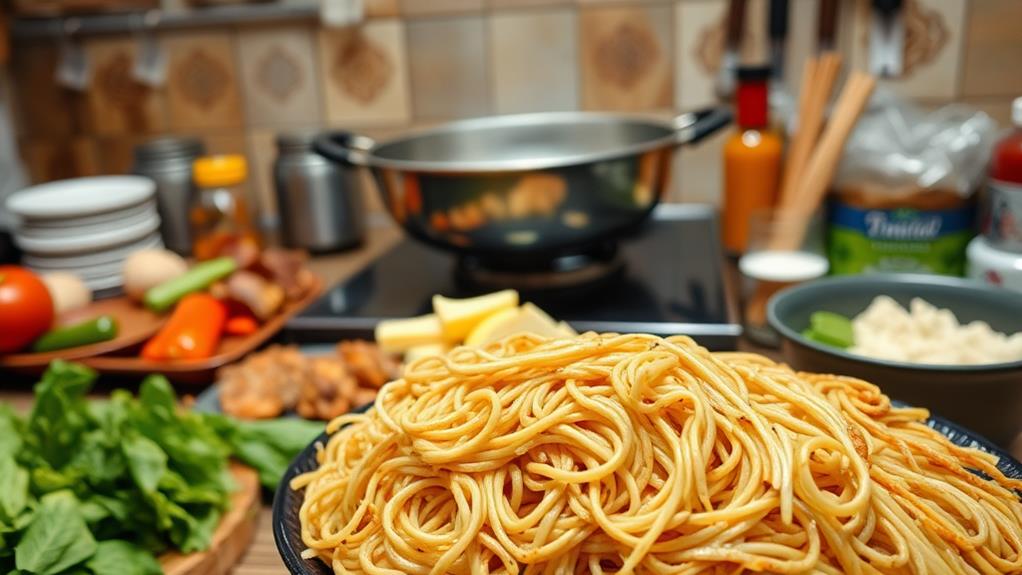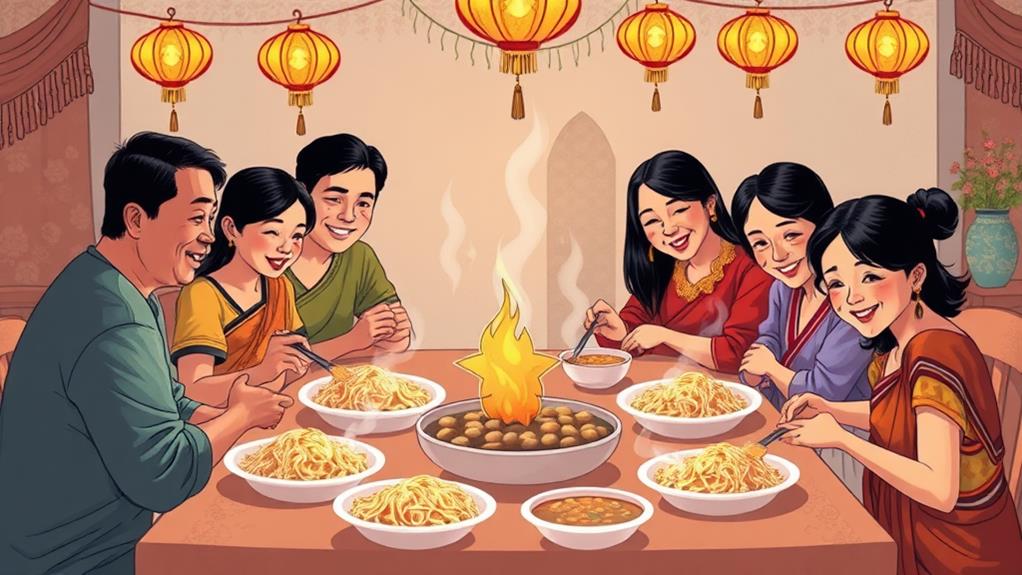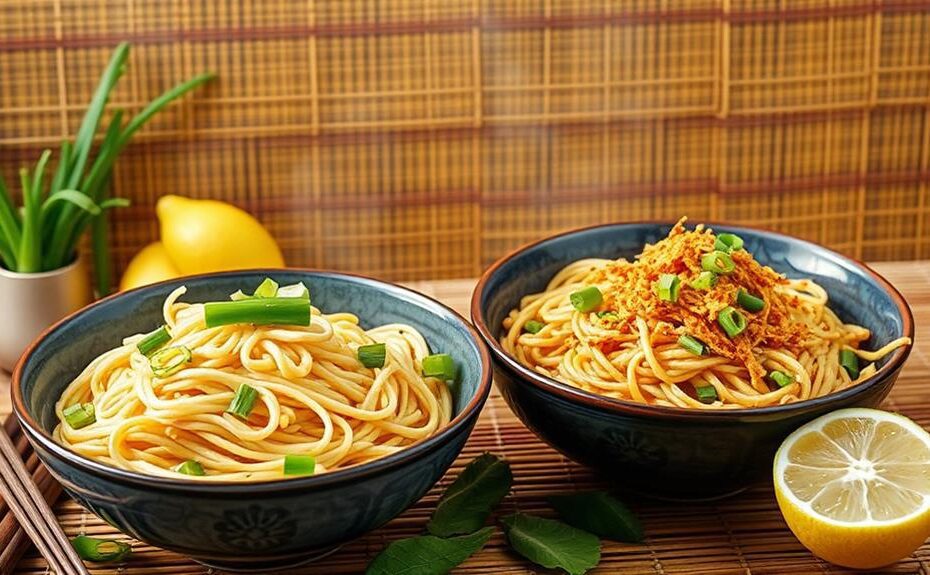Pancit Bihon and Pancit Canton are staples in Filipino cuisine due to their cultural significance and adaptability.
These noodle dishes originated from China and evolved in the Philippines, reflecting the country's cultural fusion and legacy.
They symbolize long life and prosperity in Filipino culture, making them a popular choice for celebrations and gatherings.
Easy preparation and adaptability to dietary preferences contribute to their enduring popularity. Pancit Bihon and Pancit Canton can be prepared in various ways, making them accessible to people with different tastes and dietary needs.
Their versatility allows for the incorporation of various ingredients, ensuring they can be enjoyed by everyone.
Cultural Significance Uncovered

Pancit Bihon and Pancit Canton: Cultural Significance in Filipino Cuisine
These noodle dishes bring people together, symbolizing long life and prosperity. Filipino gatherings often feature Pancit Bihon and Pancit Canton, which hold significant cultural importance. The communal aspect of Filipino dining is reflected in the way families and friends gather to share these flavorful noodle dishes, reinforcing bonds and cultural identity.
The cultural significance of Pancit Bihon and Pancit Canton lies in their ability to create a sense of community. These dishes bring people together, fostering togetherness and connection. Their versatility, allowing for various protein and vegetable combinations, adds to their appeal.
Regional diversity is highlighted through the use of different types of noodles, such as thin rice vermicelli and thicker wheat noodles. By serving Pancit Bihon and Pancit Canton at celebrations, Filipinos connect with their heritage and cultural traditions, making these dishes an integral part of Filipino gatherings.
History of Pancit's Evolution
The Origins of Pancit
The name "pancit" originates from the Hokkien term "pian e sit," meaning "conveniently cooked." This reflects its introduction to the Philippines by Chinese traders as a quick meal option.
During the Spanish colonization, pancit became a popular takeout food, with panciteros catering to factory workers.
Evolution of Pancit Dishes
The adaptation of rice flour for noodle-making led to the creation of various pancit dishes, including Pancit Bihon and Pancit Canton.
This fusion of Chinese and Filipino culinary practices highlights the cultural exchange between the two nations.
Pancit's Cultural Significance
Over time, pancit became a staple at special occasions, symbolizing long life and prosperity.
A traditional practice isn't to cut the noodles during preparation.
This cultural significance has endured, with modern adaptations of pancit continuing to evolve, including instant noodle versions.
Preparation and Cooking Techniques

Pancit Bihon and Pancit Canton: Understanding the Nuances
When it comes to preparing and cooking Pancit Bihon and Pancit Canton, understanding the distinct techniques is crucial. Soaking rice vermicelli noodles in water until softened is the essential step in preparing Pancit Bihon, followed by stir-frying with a mix of proteins and vegetables, allowing for even cooking and flavor infusion.
In contrast, boiling thick flour noodles is the initial step in preparing Pancit Canton, which is then followed by stir-frying with aromatics, meats, and vegetables, resulting in a hearty and savory dish.
A Comparison of Cooking Techniques
| Technique | Pancit Bihon | Pancit Canton |
|---|---|---|
| Noodle preparation | Soak in water until softened | Boil until cooked |
| Stir-frying | With proteins and vegetables | With aromatics, meats, and vegetables |
| Vegetable addition | Add towards the end for crunch | Mix in until tender |
Stir-Frying Techniques
Both dishes require a high-heat stir-frying technique in a large pan or wok to achieve a slight char on the noodles, enhancing their flavor and texture. Soy sauce is a key seasoning for both dishes, providing a salty and savory flavor that can be adjusted to taste, balancing the overall flavor profile of the meal.
Regional Variations and Differences
Regional Variations of Pancit Bihon and Pancit Canton
Across the Philippines, regional flavors and traditions create diverse variations of Pancit Bihon and Pancit Canton, reflecting the country's cultural heritage and geographical landscape.
Pancit Bihon Variations
Pancit Bihon, made with thin rice vermicelli noodles, is often paired with local proteins and vegetables, making it a versatile dish that caters to diverse tastes.
In coastal areas, shrimp is commonly used, while in other regions, different vegetables and spices are added to create unique flavor profiles. For example, in the Ilocos Region, Pancit Bihon is often served with vegetables like pechay and cabbage.
Pancit Canton Variations
Pancit Canton, featuring thicker wheat noodles, is often adapted with local ingredients, showcasing the region's agricultural landscape.
In areas with a strong Chinese influence, Pancit Canton is more prevalent, while in regions emphasizing rice cultivation, Pancit Bihon takes center stage.
In the Cordillera Region, Pancit Canton is often made with locally-sourced vegetables like carrots and beans.
These regional variations highlight the rich culinary diversity of Filipino cuisine, where each region adds its unique touch to these beloved dishes.
By exploring these variations, you'll gain a deeper understanding of the country's cultural heritage and geographical landscape.
Symbolism and Tradition Explained

Filipino Noodles Symbolize Long Life and Prosperity
In the Philippines, Pancit Bihon and Pancit Canton are served at significant celebrations, such as birthdays, weddings, and holidays, to represent long life and prosperity. When served at a birthday party, Pancit Bihon is more than just a meal; it's a cultural tradition.
By replacing the traditional birthday cake, Pancit Bihon emphasizes the importance of sharing food as an expression of love and community.
The Tradition of Not Cutting Noodles
The tradition of not cutting the noodles is rooted in the symbolism of long life, as it's believed to extend the lifespan of the celebrant. This tradition highlights the cultural significance of Pancit in Filipino cuisine.
Adaptability of Pancit
The adaptability of Pancit, with its various regional variants and customizable ingredients, showcases the blend of culinary influences in Philippine cooking.
As you savor each strand of noodle, you're partaking in a tradition that's deeply ingrained in Filipino culture, one that celebrates the joy of sharing meals with others.
Impact on Filipino Identity
Pancit Bihon and Pancit Canton reflect the cultural heritage of the Filipino people. These noodle dishes have become an integral part of Filipino celebrations, symbolizing long life and prosperity.
They reinforce cultural identity during significant events, such as birthdays, weddings, and holidays.
The adaptation of Chinese culinary influences into Filipino culture is evident in Pancit Bihon and Pancit Canton. This cultural exchange has shaped Filipino identity and is a testament to the country's rich history.
Sharing these dishes strengthens familial bonds and community connections, which are central to the Filipino values of hospitality and togetherness.
Regional variations of Pancit Bihon and Pancit Canton showcase the diversity of Filipino culinary heritage. Across different regions, local ingredients and culinary practices contribute to the unique flavors and textures of these dishes.
These variations serve as a medium for storytelling and memory, linking generations through family traditions and recipes passed down.
Pancit Bihon and Pancit Canton preserve Filipino cultural identity by connecting people to their heritage and traditions. These noodle dishes are more than just food; they're a symbol of the Filipino people's history, culture, and values.
What Makes Pancit Bihon and Pancit Canton Stand Out in Filipino Cuisine?
Pancit Bihon and Pancit Canton are iconic Filipino noodle dishes. What sets the Filipino pancit canton dish apart is the unique combination of flavors and textures. The mix of stir-fried noodles, vegetables, and savory meats creates a hearty and satisfying dish that is loved by many.
Culinary Innovation and Legacy

Pancit Bihon and Pancit Canton's Versatility Drives Culinary Innovation
These Filipino noodle dishes have inspired creative experimentation among home cooks and professional chefs, leading to the incorporation of diverse ingredients and cooking techniques. For instance, they now feature a wide range of proteins, such as traditional pork and chicken, as well as modern options like tofu and seafood.
Notable Aspects of Pancit Bihon and Pancit Canton's Culinary Innovation and Legacy
Cultural Fusion: The dishes blend Chinese and Filipino culinary traditions, resulting in unique flavors and cooking techniques. This fusion is evident in the use of soy sauce, a staple in Chinese cuisine, combined with Filipino ingredients like patis (fish sauce) and calamansi (Philippine lime).
Ease of Preparation: Pancit Bihon and Pancit Canton are quick to prepare and cook, making them favored choices for both home cooks and professional chefs. This convenience is due to the simplicity of the recipes and the use of readily available ingredients.
Dietary Versatility: These dishes can cater to diverse dietary preferences, enhancing their appeal across different demographics. For example, vegetarians and vegans can substitute meat with tofu or tempeh, while those with gluten intolerance can use gluten-free soy sauce.
Evolution in Modern Cuisine: Pancit Bihon and Pancit Canton continue to evolve, incorporating new ingredients and cooking techniques to ensure their relevance in modern Filipino cuisine. This evolution is driven by the creativity of chefs and home cooks who experiment with innovative flavors and presentation styles.
Frequently Asked Questions
Why Is Pancit so Popular in the Philippines?
Pancit is a deeply rooted cultural symbol in the Philippines. This is evident in its presence at festive occasions and family gatherings, where it symbolizes long life and prosperity.
In these celebrations, pancit serves as a unifying factor, bringing people together and fostering a sense of community.
The dish has evolved to cater to diverse tastes. With regional variations, pancit has become a staple at both celebrations and everyday meals.
Its adaptability is key to its popularity, allowing it to be enjoyed by people from different walks of life.
Pancit's significance extends beyond its culinary appeal. It serves as a connection to Filipino heritage, reminding people of their cultural roots.
By sharing a plate of pancit, Filipinos bond over their shared identity, strengthening family ties and community bonds.
What Is the Difference Between Pancit Bihon and Pancit Canton?
Pancit Bihon and Pancit Canton are two distinct varieties of pancit noodles.
Pancit Bihon uses thin rice vermicelli noodles, whereas Pancit Canton uses thick, wheat-based egg noodles. This difference in noodle type affects the cooking method. For Pancit Bihon, the noodles are soaked and then stir-fried, whereas Pancit Canton noodles are boiled and then stir-fried.
Regional flavors also differentiate Pancit Bihon and Pancit Canton.
Pancit Bihon is often seasoned with soy sauce and savory broth, giving it a distinct flavor. In contrast, Pancit Canton features coconut milk and spices, resulting in a unique taste.
Where Does Pancit Bihon Originate?
Pancit Bihon originates from the Chinese Hokkien phrase "pian e sit," meaning "conveniently cooked." This name reflects its easy preparation method with rice vermicelli noodles.
The cultural significance of Pancit Bihon in Filipino cuisine is evident in its regional variations, which have emerged over time. The cooking techniques and ingredient diversity have been adapted to local tastes, making it a staple in Filipino celebrations and gatherings.
Why Does Pancit Symbolize Long Life?
Pancit symbolizes long life in Filipino culture because the long noodles represent longevity and prosperity. This symbolism is rooted in the hope for a long and fruitful life.
At festive occasions like birthdays and weddings, pancit is a staple dish. These family gatherings emphasize the importance of good fortune and health.
By serving pancit, you're essentially wishing loved ones a long and prosperous life. This tradition is deeply ingrained in Filipino cuisine, making pancit a beloved dish.
